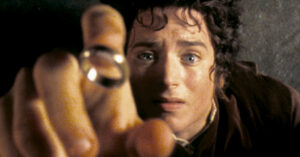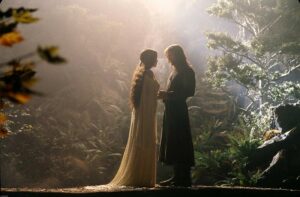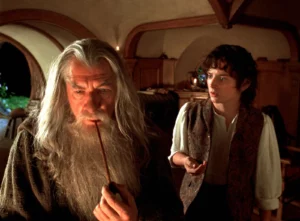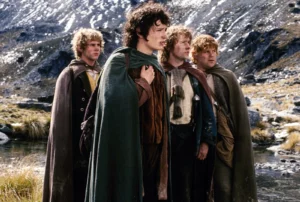The Lord of the Rings: The Fellowship of the Ring (2001) review
Dir. Peter Jackson
By: Steve Pulaski
Rating: ★★★½
NOTE: This is a review of the theatrical version of The Fellowship of the Ring.
It’s been roughly 11 years since I first watched The Lord of the Rings: The Fellowship of the Ring. I never pressed play on the sequels. Devout readers know my difficultly with the fantasy genre: I’m always within arm’s reach of appreciation, and almost exclusively removed from obsession. I’m sure I’ll get some mail from people demanding I watch the extended editions. Maybe one day down the road, but for now, I needed to tackle arguably my biggest blind-spot as a film critic — as all viewers initially witnessed them.
What more can be written about J. R. R. Tolkien’s Lord of the Rings trilogy? Book or movie, it’s one of the most revered trilogies of all time, and Tolkien remains one of modern fantasies founding fathers. Film critic James Berardinelli said it best: “While The Lord of the Rings may not be the longest or most complex fantasy series to date, it remains the standard against which all similar works are measured.”
Based on Tolkien’s novel, published in 1954, 17 years after The Hobbit, The Fellowship of the Ring begins in the peaceful countryside of the Shire on Middle-earth. It’s where Bilbo Baggins (Ian Holm) is celebrating his 111th birthday amongst his fellow Hobbits. In attendance is Frodo (Elijah Wood), the heir to Bilbo’s fortunes, along with Gandalf the Grey (Ian McKellen), a wizard and mentor to Frodo. Bilbo is in possession of the One Ring, created and once utilized by Dark Lord Sauron (Sala Baker) in an attempt to conquer Middle-earth. During his birthday celebration, Bilbo gives it to Frodo, who learns of its dark and troubling history from Gandalf. The ring itself has the power to corrupt its wearer, and therefore must be destroyed.

With the help of Gandalf, Frodo, along with his friend Samwise (Sean Astin); a ranger named Aragorn (Viggo Mortensen); Boromir (Sean Bean), a son of the Stewards of Gondor; Legolas (Orlando Bloom), a prince of the elves; and fellow Hobbits Merry and Pippin set a course to Mount Doom to destroy the One Ring for good.
If only it were so easy. The previous wearer of the ring was a feral creature named Gollum, who was captured and tortured by Sauron’s Orcs even long after losing possession of it. Gandalf realizes that Sauron and his Orcs will come for Frodo if the ring is not destroyed, but by the time the Fellowship is en route, so is Sauron, on a quest to take back what is his.
I suppose part of my long-held apprehension to The Lord of the Rings series was a fear of alienation due to the onslaught of characters and abundance of mythology, the likes of which I still contend you need to study over the course of years to fully admire. Writer/director Peter Jackson (working with Fran Walsh and Philippa Boyens in the screenplay department) manage to contextualize a great deal through first act narration before leaving it up to the characters to further. The fundamental issue of origins stories — spending so much time laying the foundation that when the time comes for the real meat of the story, it’s also time for the credits to roll — isn’t present with The Fellowship of the Ring. After about 45 minutes of worldbuilding and contextualizing, the Fellowship is off on their journey.

While the action and swordplay dazzles on a technical level, I found myself most captivated by the moments punctuating the battles. Jackson and company underscore those moments with a tenderness and relaxed tone that puts them at stark contrast to the battles that often bookend them. They’re also necessary lulls (although I hate calling them that) when the combat gets to be a bit much. One of my favorite scenes is a shared moment between Aragorn and his lover Arwen (Liv Tyler, one of the only actresses in the film), an elf of Rivendell. At one point, the two reminisce about how they first met:
“You said you’d bind yourself to me, forsaking the immortal life of your people,” Aragorn reminds her, as if she needs to be reminded. “And to that I hold,” Arwen replies. “I would rather share one lifetime with you than face all the ages of this world alone.” In a film series where the stakes, visuals, and special effects are all cranked up to capacity, The Fellowship of the Ring is brimful with moments where quiet reflection breeds reminders of the power that this series holds for many. Fantasy dazzles us with its mythical nature, but, like art as a whole, attracts and moves us by what it reveals of our most inner-selves and our accompanying desires.
I felt the same way about the many interpersonal conversations between Frodo and Gandalf. Of all the fine performances on-screen, it often feels as if Ian McKellen, the actor and his character, is the glue of the film. His grandfatherly direction and philosophical nature command your attention, and even when he is away from the Fellowship, his presence looms over the movie like that of a deity.

As far as bigger setpieces are concerned, the group’s dangerous pilgrimage through Moria stands as one of its most impressive. It happens relatively early, but it still signifies the peril inherent to the trip. All the feelings you’d expect to come with such an odyssey wash over you, even in what is essentially the first act: triumph, loss, guilt, finding one’s inner-strength, and the strength of a collective.
You don’t need me to tell — more like remind — you that The Fellowship of the Ring is a massive technical achievement, but I will anyway. Peter Jackson outdoes expectations by having a flurry of devices coalesce into a marvel of visionary brilliance. Everything from the set design to the locations themselves are fully realized; as such, the characters feel ingrained in this world. Andrew Lesnie’s cinematography gives the film the kind of epic presentation that is comparable to Lawrence of Arabia and other great works of the genre.
As a way to elongate the feeling of embarking on a long journey — and, frankly, to give myself time to digest between installments — I’ll be revisiting Middle-earth every Monday until the trilogy is complete. Some are braver than myself, and hold marathons of the extended editions of the trilogy; some even start with the three Hobbit films before even touching Jackson’s trilogy. Bless them and their devout nature. They are stronger than I. I’ve put off this series for long enough. What’s another couple week’s time?
NOTE: As of this writing, The Lord of the Rings: The Fellowship of the Ring is currently streaming on both Netflix and HBO Max.
My review of The Lord of the Rings: The Two Towers
My review of The Lord of the Rings: The Return of the King
Starring: Elijah Wood, Ian McKellen, Sean Astin, Viggo Mortensen, Liv Tyler, Cate Blanchett, John Rhys-Davies, Billy Boyd, Dominic Monaghan, Orlando Bloom, Christopher Lee, Hugo Weaving, Sean Bean, Ian Holm, Andy Serkis, and Sala Baker. Directed by: Peter Jackson.
About Steve Pulaski
Steve Pulaski has been reviewing movies since 2009 for a barrage of different outlets. He graduated North Central College in 2018 and currently works as an on-air radio personality. He also hosts a weekly movie podcast called "Sleepless with Steve," dedicated to film and the film industry, on his YouTube channel. In addition to writing, he's a die-hard Chicago Bears fan and has two cats, appropriately named Siskel and Ebert!


